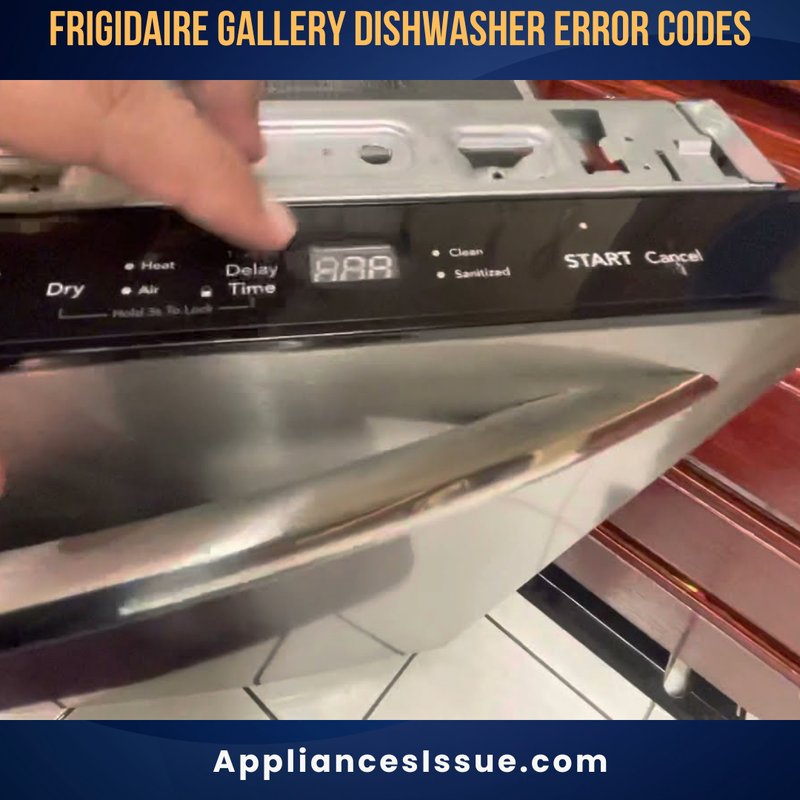
Imagine you’re trying to fill a bathtub with water and someone has inadvertently turned off the tap after just a few seconds. Frustrating, right? Well, that’s essentially what’s going on with your dishwasher when the E3 error code pops up. It indicates that there’s an issue with the water heating process. Dishwashers need to heat water to a certain temperature to clean effectively, and if they can’t, they’ll let you know with this code.
Understanding what’s happening can make you feel more in control and a bit like a tech detective. So, if you’re ready, let’s dive in and explore why this error occurs and what you can do to fix it.
Understanding Error Code E3: The Basics
E3, in the world of Frigidaire dishwashers, revolves around the water heating system. The code generally means that the dishwasher isn’t able to heat water to the required temperature within a specific time frame. Think of it like trying to bake a cake at the wrong temperature—things just don’t come out as they should. In a dishwasher, proper water temperature is crucial for dissolving detergent, sanitizing your dishes, and ensuring they come out sparkling clean.
Now, you might be asking, why does water temperature matter so much? Well, hot water helps to dissolve food particles and grease more efficiently. Imagine trying to wash a greasy pan with cold water; not very effective, right? The same principle applies here. When the dishwasher can’t heat the water as needed, it sends out the E3 signal to alert you to take action.
There are a variety of reasons why the water might not be heating properly. It could be something as simple as a faulty thermostat, or it could be a problem with the heating element itself. Sometimes, it’s an issue with the wiring or even the control board. Each of these components plays a part in how your dishwasher heats water, much like how each ingredient contributes to baking that perfect cake.
Common Causes of the E3 Error Code
So, what exactly causes the E3 error to appear? The first culprit is often a malfunctioning heating element. The heating element is like the heart of the heating process. If it’s not working correctly, the water won’t get hot enough, hence the error message. Picture it as a radiator in your car; if it’s not functioning, your car’s not going to heat up, and that spells trouble.
Another common cause is a defective thermostat. The thermostat’s job is to measure the water temperature. If it’s not reading the temperature accurately, it might prevent the dishwasher from heating the water properly. Imagine trying to follow a recipe if your oven’s temperature gauge is broken—you’ll likely end up with an undercooked cake. Similarly, an inaccurate thermostat can throw a wrench in the works of your dishwasher.
Lastly, wiring issues or a faulty control board can also trigger the E3 code. These components act like the brain and nerves of your dishwasher, sending signals and instructions to various parts. If the signals aren’t getting through, then certain functions, like heating, won’t work right. It’s akin to trying to listen to a radio with static interference, hindering the clear signal and causing confusion.
Fixing the E3 Error: Troubleshooting and Solutions
Now that you know what could be causing the E3 error, let’s talk about what you can do to fix it. First, you can start by checking the heating element. Ensure the dishwasher is unplugged, and then locate the heating element, typically found in the bottom of the tub. You can test it with a multimeter to check for continuity. If it’s faulty, it’ll need replacing. It’s like swapping out a burnt-out light bulb to restore light.
If the heating element is in good shape, it’s time to look at the thermostat. This can also be tested with a multimeter. If the readings are off, then this part may need to be replaced. It’s a bit like recalibrating your home’s thermostat to ensure your rooms are the perfect temperature.
When these two main components are functioning correctly, but the E3 error persists, the issue may lie in the wiring or control board. This can be a bit more complex, so if you’re not comfortable inspecting or replacing these parts yourself, it might be time to call in a professional. Sometimes, just as you might call a mechanic to fix a complex car issue, getting expert help ensures the job is done safely and correctly.
Preventing Future E3 Errors
Avoidance is often the best strategy, and the same goes for preventing the E3 error in your Frigidaire dishwasher. Regular maintenance is key. Just as you’d service your car to prevent breakdowns, keeping your dishwasher in tip-top shape can help stave off errors. Check and clean the filters regularly, as clogs can affect water flow and temperature.
Another tip is to avoid overloading the dishwasher. When too many dishes are jammed inside, it can hinder water circulation and heating. Think of it like trying to run in a crowd; it slows you down and makes it difficult to move efficiently. Make sure to load your dishes with enough space between them for water to flow freely.
Lastly, keep an eye on your appliance’s performance. If you notice cycles taking longer or dishes not coming out as clean as usual, it could be an early sign of heating issues. Catching these signs early can help you address minor problems before they escalate into full-blown errors. By taking these preventative steps, you can help ensure your dishwasher runs smoothly, keeping your kitchenware sparkling without the unexpected interruptions of error codes.